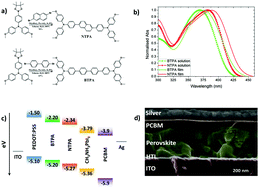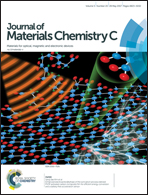High mobility, hole transport materials for highly efficient PEDOT:PSS replacement in inverted perovskite solar cells†
Abstract
Perovskite solar cells are one of the most promising photovoltaic technologies due to their rapid increase in power conversion efficiency (3.8% to 21.1%) in a very short period of time and the relative ease of their fabrication compared to traditional inorganic solar cells. One of the drawbacks of perovskite solar cells is their limited stability in non-inert atmospheres. In the inverted device configuration this lack of stability can be attributed to the inclusion of poly(3,4-ethylenedioxythiophene) polystyrene sulfonate (PEDOT:PSS) as the hole transporting layer. Herein we report the synthesis of two new triarylamine based hole transporting materials, synthesised from readily available starting materials. These new materials show increased power conversion efficiencies, of 13.0% and 12.1%, compared to PEDOT:PSS (10.9%) and exhibit increased stability achieving lifetimes in excess of 500 hours. Both molecules are solution processible at low temperatures and show potential for low cost, scalable production of large scale perovskite solar cells on flexible substrates.



 Please wait while we load your content...
Please wait while we load your content...